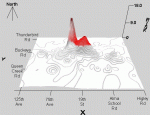Main Research Findings
Among the key discoveries resulting from the first three years of (CAP) LTER, three stand out for their scientific generality and potential social relevance:
- In a comprehensive study of the nitrogen mass balance for the CAP ecosystem, anthropogenic sources far outstrip natural sources of Nitrogen (N). More interestingly, vegetation and soils in the city are likely sinks for retaining much of the enormous quantities of N from combustion-derived NOx production (Baker et al. in review). This detailed N mass balance is a first for an agro-urban ecosystem and is thus a landmark effort.
- Our urban-fringe study has determined that the spread of the city through the construction of new single-family houses at the periphery is instrumental in determining changes in key ecological variables such as microclimate, soils, and vegetation cover. Initial data came from county records, but are now being supplemented with aerial photos to monitor land-use change. The remote-sensing team is developing a classification scheme.
- Examining sources of toxic releases and patterning of air pollution in Phoenix neighborhoods reveals that ethnic minorities and the poor are exposed to greater environmental hazards (Bolin et al. 2000). However, with the shift from traditional smokestack polluters to new economy chip manufacturers, comes a greater tendency for polluters to locate in more affluent neighborhoods.
Understanding the ecological changes that accompany new housing and urban sprawl will allow for more rational city planning; knowledge of nutrient sources and sinks in an urban environment will help guide a more responsible use of commercial fertilizers; gaining insights on the nature of environmental risks and how they are differentially borne by citizens will enhance city planning and possibly our quality of life. To learn more, visit http://capleter.asu.edu/nuggets.shtm
Third Annual Symposium
CAP LTER researchers and community partners gathered on January 19 at ASU to showcase current research on the Phoenix ecosystem. Project Co-Director Nancy Grimm summarized the results of three years of CAP LTER, which has involved over 300 participants, 100 faculty members, 75 graduate students from the life, earth, and social sciences, 60 K-12 teachers, 37 schools in 14 districts, 25 undergraduates, 8 postdocs, 20 active community partners, and 100 community volunteers. We have given 200 talks and poster presentations at national, regional, and local meetings, published over 45 journal articles, books, and book chapters. The Ecology Explorers program has introduced inquiry-based science to thousands of school children and teachers.
New this year were 10 posters that synthesized the results of the our main research areas: Modeling, Survey 200, Data Management, Populations, Primary Production, Biogeochemical Processes, Geophysical Context, Human Dimensions of Ecological Change, and K-12 Education. The symposium sparked discussion among the 160 visitors-and among potential CAP participants-a main goal of our wide ranging, interdisciplinary study of an arid, urban ecosystem. To learn more, visit http://capleter.asu.edu/Symposia/symp2001/
Environmental Risk Group (ERG): Paving the Way for Interdisciplinary Cooperation
Environmental justice is a relatively new theme that transcends disciplines, yet is founded on bedrock issues at the juncture of physical, life, and social sciences, and human rights.
ERG research is grounded locally, which lends immediacy and a sense of purpose. The ERG approach borrows data, tools and ideas from a broad spectrum of disciplines. Graduate students contribute energy, commitment, ideas, and new techniques. Faculty members contribute conceptual frameworks, interpretations, and experience. The different disciplines and varying perspectives create a reflective learning environment for graduate students and faculty members alike.
Diversity of faculty members, student-faculty mix without superior-subordinate roles, flexibility to accommodate new courses or materials, the need to get away from disciplinary cultures-all are responsible for the success or longevity they have achieved.
Members of the ERG include:
- Amy Nelson (CES)
- Bob Bolin
- Ed Hackett
- Maureen O'Donnell
- Diane Sicotte (Sociology)
- Larissa Larsen and David Pijawka (Planning and Landscape Architecture)
- Scott Smith (GIS Lab)
- Ed Sadalla (Psychology)
- Eric Matranga (Geography)
- Debbie Brewer (Environmental Resources)

 Enlarge this image
Enlarge this image